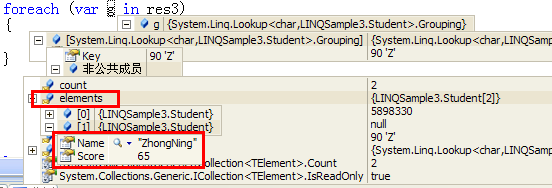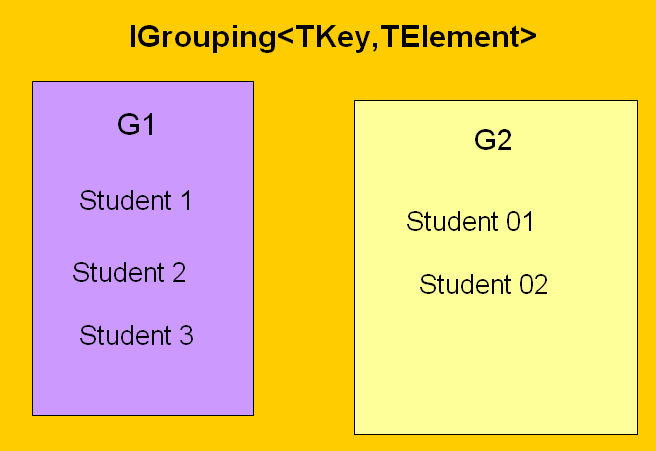- int[] Source1 = new int[] { 10, 50, 22, 38, 91, 17 };
- // 筛选出大于20的数字
- var res =
- from n in Source1
- where n > 20
- select n;
- Debug.Write(" 大于20的整数有: ");
- foreach (int x in res)
- {
- Debug.Write(" " + x);
- }
输出的结果为:
- 大于20的整数有:
- 50 22 38 91
复合条件的写法与if等判断语句一致,LINQ遵循C#语法,再看看下面一个例子,从字符串数组中选出以T开头并且长度大于等于3的。
- string[] Source2 = new string[]{
- "Time", "Apple", "Noooooode", "DogDoorDoc", "TikkyOde"
- };
- var res2 =
- from s in Source2
- where s.StartsWith("T") && s.Length >= 3
- select s;
- Debug.Write(" 以“T”开头并且长度在3以上的字符串有: ");
- foreach (string str in res2)
- {
- Debug.Write(" " + str);
- }
输出结果如下:
- 以“T”开头并且长度在3以上的字符串有:
- Time TikkyOde
二、group子句。
这是一个有点儿难度的子句,很多朋友可能搞不清楚它查询后返回的是什么。这样,我们还是用一个例子来说明吧。
首先,声明一个类,包含两个字段:学生姓名和成绩。
- public class Student
- {
- public string Name { get; set; }
- public int Score { get; set; }
- }
接着,我们把学生的名字以首字母进行分组。
- Student[] Source3 = new Student[]{
- new Student{Name="ZhangFeng", Score = 60},
- new Student{ Name = "LiuXiaoShan", Score = 75 },
- new Student{ Name = "LiangWuTai", Score = 80 },
- new Student{ Name = "ZhongNing", Score = 65 },
- new Student{ Name = "FuNan", Score = 71 },
- new Student{ Name = "LanAo", Score = 79 },
- new Student{ Name = "FangTianHao", Score = 88 }
- };
- var res3 =
- from st in Source3
- group st by st.Name[0];
- Debug.Write(" 查询结果变量的类型:" + res3.GetType().Name + " ");
- Debug.Write(" 分别输出各分组的信息: ");
- foreach (var g in res3)
- {
- Debug.WriteLine("数据类型:" + g.GetType().Name);
- }
调试运行,然后注意查看“输出窗口”中的内容。
- 查询结果变量的类型:GroupedEnumerable`3
- 分别输出各分组的信息:
- 数据类型:Grouping
- 数据类型:Grouping
- 数据类型:Grouping
因此,我们可以得到这样的结果:
1、分组查询返回一个GroupedEnumerable;
2、每个GroupedEnumerable中包含N个Grouping。
我们发现这些类在对象浏览器中找不到,GroupedEnumerable是内部类,但Grouping通过反射也没找着,那它们的结构到底如何?
现在,我们通过断点调试,进一步了解它们。


从截图中我们看到,IGrouping<TKey,TElement>有一个Key属性,其实它就是存储我们用来进行分组的键,怎么理解呢?
回到上面的例子,我们以什么作为分组的依据?对,姓名字段的第一个个字母,其实是Char类型,因此,比如上面的,“Z”就是一个组的键,在这个组里面,都是以Z开头的对象的集合。
我们可以下一个不成文的结论:分组结果中的所谓Key就是我们用于分组所依据的字段或具体的值。
在实现IGrouping<TKey,TElement>的类中,显然会实现GetEnumerator方法,也就是说我们可以把它foreach出来,上图中看到,每个元素(TElement)说白了就是已经被分组的对象,上例中即为Student对象。
而每个组中其实包含Lookup<TKey,TElement>类。
呵呵,有些混乱了,我们可以这样总结:
执行了LINQ分组查询后,得到的所有分组的集合A,而A中的每个成员就是一个组G1、G2……而G1中就是被分到该组的对象O1、O2……可能用一个图来表示会直观一点。

现在,我们把上面的代码改一下。
- foreach (var g in res3)
- {
- Debug.WriteLine(g.Key);
- foreach (var item in g)
- {
- Debug.WriteLine("姓名:" + item.Name);
- Debug.WriteLine("成绩:" + item.Score);
- }
- }
输出结果如下:
- Z
- 姓名:ZhangFeng
- 成绩:60
- 姓名:ZhongNing
- 成绩:65
- L
- 姓名:LiuXiaoShan
- 成绩:75
- 姓名:LiangWuTai
- 成绩:80
- 姓名:LanAo
- 成绩:79
- F
- 姓名:FuNan
- 成绩:71
- 姓名:FangTianHao
- 成绩:88